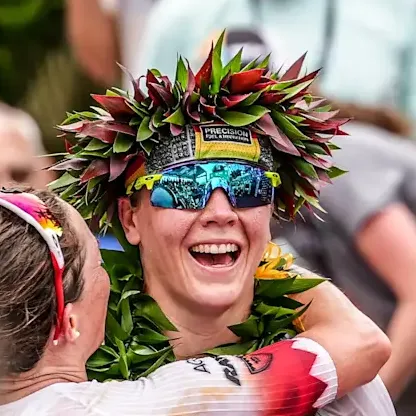
Solveig Løvseth
Precision Fuel & Hydration IRONMAN 70.3® World Championship
Solveig's headline numbers
Solveig's strategy
Fueling
Carbohydrate is the main fuel you burn when racing. Failing to fuel properly is a leading cause of underperformance in longer races.
Like she did when she won the IRONMAN® World Championship in Kona a month earlier, Solveig stuck with her high-carb, "bottles-not-aid-stations" approach for the bike, carrying all of her fuel right from the start. She fueled with a PF 300 Flow Gel in a 500ml bottle and a 750ml bottle with 30g of PF Carb Only Drink Mix and a PH 1500 (Tabet), along with two PF 30 Caffeine Gels ready to have at the same time. Together, this allowed her to hit an impressive ~156g/h of carb per hour across the bike with zero stomach discomfort.
Solveig had to think quickly on the run when her pre-planned flasks did not appear at either of the pro aid stations. She’d planned to have one PH 1500 (Tablet) and a PF 90 Gel in her first flask, with the second flask having two scoops of Carb Only Drink Mix, since she only needed 30g of carbs at the late stage of the run. Luckily, she started strong by carrying a soft flask with 45g of Carb Only Drink Mix and a PH 1500 (Tablet) in it. But after realising her planned carbs weren’t going to be available, she had to pick up some on-course gels, which, in her own words, “took some effort to get down”. That said, her high fueling on the bike and quick thinking on the run kept her carb availability high enough to maintain her energy across the third leg, despite the small discomfort that came with the unfamiliar gels.
Hydration
Taking on board an appropriate amount of fluid and sodium is essential to maintaining blood volume and supporting the cardiovascular effort needed to perform on race day.
Whilst the absolute amount of sodium and fluid consumed per hour is important, it’s critical to consider these in relation to each other. This is known as 'relative sodium concentration' and it’s expressed in milligrams per litre (mg/L). How much sodium you’re taking in per litre of fluid is more important than the absolute amount taken in per hour.
Sweat sodium concentration (mg/L) is largely genetically determined and remains relatively stable. Knowing how salty your sweat is enables you to replace a good proportion of your sweat losses, which can range from 200-2,000mg/L.
Whilst Solveig’s losses are on the moderate side, getting her hydration strategy right is still crucial when it’s hot and/or humid as her higher sweat rate in these conditions can result in significant net losses over the duration of a race.
Learn moreSolveig followed our preloading guidance, starting hydrated with 500ml of PH 1500 (Tablet) with breakfast. On the bike, she started with one 750ml bottle with a PH 1500 (Tablet) in which, when diluted in a 750ml bottle, provided a relative sodium concentration of 1000mg/L. Knowing that she could pick up her remaining fluid and electrolytes from the PH 1000 (Tablet) available on course, which matches her sweat sodium concentration, meant that she could start the bike leg relatively “light” on fluids to make the first major climb that tiny bit easier. Mixing plain water from aid stations with PH 1500 (Tablet) in the two soft flasks meant that her overall relative sodium concentration was spot on across the race to match her sweat sodium losses.
Caffeine
Beyond the Three Levers of Performance (carb, sodium and fluid), caffeine is one of only a few substances that is proven to improve performance for most endurance athletes as it can help stave off mental and physical fatigue.
Solveig might be the queen of Kona, but she’s also the queen of double-dropping PF 30 Caffeine Gels. Her strategy remained loosely similar to Kona, albeit with one less dose, given the shorter duration of a 70.3®. She started with two PF 30 Caffeine Gels before the swim start and followed it up with another two PF 30 Caffeine Gels around 2 hours into the bike. With the time it takes for caffeine to be fully absorbed (30-60 minutes), this final dose would have started working at maximum ergogenic effects at the start of and across the run to see her through to the finish.
How Solveig hit her numbers
Here's everything that Solveig ate and drank on the day...
Solveig's weapons of choice
Final thoughts
Solveig's full stats
Data Confidence?
There is good confidence in the accuracy of the data reported. An athlete feels that the numbers closely reflect what they consumed despite a couple of estimations which may carry some degree of error. The majority of what was consumed is recorded to a high level of specificity (most volumes are known through the use of bottles brands quantities flavours). The numbers are very plausible and align with previous data recordings (if an athlete has collected data previously).